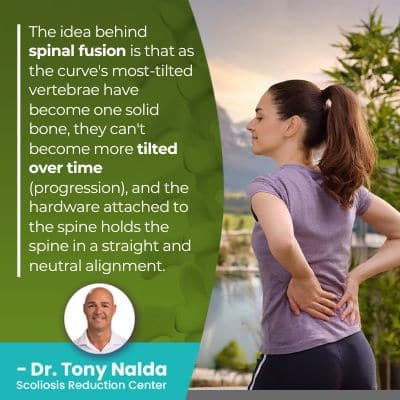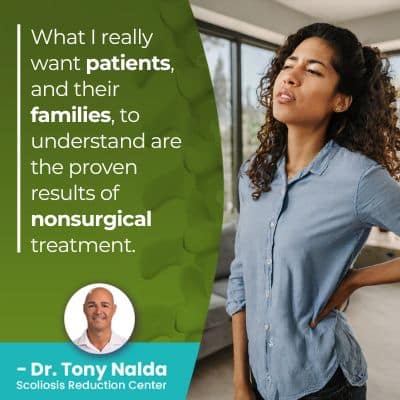Does Scoliosis Surgery Work? [Treatment Options Explained]

Whether or not scoliosis surgery works will be case-specific; each patient will respond to spinal fusion in their own way, and this is shaped by a number of variables that differ from one patient to the next. Scoliosis treatment can shape long-term spinal health and function, and scoliosis surgery is associated with a number of potential complications and side effects.
When it works, scoliosis surgery stops scoliosis from getting worse by fusing vertebrae together, and holding the spine's position with metal rods attached to the spine with pedicle screws; when it doesn't work, there can be complications, hardware can fail, and/or progression still occurs.
Before getting to the specific effects of scoliosis surgery, let's discuss the procedure itself.
Table of Contents
Scoliosis Treatment Options
As a progressive spinal condition that involves the development of an unnatural sideways curvature of the spine that also twists, the way a diagnosis is responded to is crucial; scoliosis treatment is about managing a life-long condition, and the type of treatment applied shapes the spine's health and function.
Once a diagnosis of scoliosis is given, the most important decision to be made is which treatment approach to commit to because different types of treatment affect the spine differently.
The two main scoliosis treatment options are known as traditional surgical treatment and modern conservative nonsurgical treatment.
Scoliosis is a spinal condition that's been around since ancient times, and for many years, traditional treatment was the dominant, or only, option presented, but the reality is that many cases of scoliosis don't require surgical treatment, particularly those that are diagnosed and treated early.
To determine whether or not surgery for scoliosis works, let's first discuss the procedure itself, along with its associated risks.
Scoliosis Surgery
Surgery for scoliosis is commonly a type of spinal fusion, and this involves fusing the curve's most-tilted vertebrae, at its apex, into one solid bone, and then rods are often attached to each side of the spine to hold it in position.
 There are different types of scoliosis surgery with different methods of accessing the spine; posterior spinal fusion accesses the spine from the back, and anterior scoliosis correction accesses the spine through the side.
There are different types of scoliosis surgery with different methods of accessing the spine; posterior spinal fusion accesses the spine from the back, and anterior scoliosis correction accesses the spine through the side.
Vertebral body tethering that is a type of fusion that involves minimally invasive techniques so is more appropriate for treating spines that are still growing: can involve making smaller incisions, the use of growing rods, or tethers that hold the spine in place with tension that can be adjusted in response to a child's growth.
The idea behind spinal fusion is that as the curve's most-tilted vertebrae have become one solid bone, they can't become more tilted over time (progression), and the hardware attached to the spine holds the spine in a straight and neutral alignment.
The surgical procedure also involves the removal of intervertebral discs that sit between adjacent vertebral bodies to be fused, and the spine's discs play many important roles in maintaining spinal health and function.
Spinal fusion is a major surgery, so its risks need to be fully understood.
The spine's vertebrae are stacked on top of one another, and adjacent vertebrae are separated by an intervertebral disc; the discs give the spine structure (adjacent vertebrae attach to the disc in between), flexibility, provide cushioning, and act as the spine's shock absorbers, so their removal isn't ideal and will have effects.
Removing spinal discs often involves a bone graft, and holding the spine in place is contrary to its natural movement-based design, and the surgery itself is associated with a number of risks:
- Nerve damage
- Infection
- Excessive blood loss
- Adverse reaction to hardware used
The length of a patient's recovery time will vary based on a number of variables:
- Whether or not there were any complications during the procedure
- Patient age and overall health
- Condition type
- Condition severity
- The location of vertebrae fused
- The number of vertebrae fused
The primary goal of spinal fusion surgery is to stop the condition from getting worse, and theoretically, holding the spine in a straighter position so it can't become more unnaturally bent and twisted can work, but what is it actually like to live with a fused spine?
Long-Term Effects of Spinal Fusion Surgery
While spinal fusion surgery can indeed straighten a bent spine, the way it achieves this can cost the spine in other ways.
Fusing the spine and attaching metal rods to hold the spine's alignment is contrary to the spine's natural and movement-based design, and this is what many patients are disappointed with as there can be a noticeable loss in spinal flexibility and range of motion.
When the spine is more rigid, it can also be more painful, particularly around the fusion site, and if there is a noticeable loss in spinal flexibility, this can mean activity restrictions and/or not being able to participate in once-loved activities.
In addition, a fused spine is not going to be as strong, so is weaker and more vulnerable to injury, and once a spine is fused, it's fused for life; it the surgery is unsuccessful for any reason, the only recourse is more surgical treatment, and the risks of spinal surgery increase with each subsequent procedure, and with increasing age.
So there is also the very-real psychological effect of living with a fused spine that can be overlooked; some patients find the knowledge of living with a weaker spine causes fear of trying new things, affecting overall quality of life.
The reality is that any spinal surgery is going to come with risks, but many cases of scoliosis don't require surgical treatment, thanks to the emergence of a conservative nonsurgical treatment alternative.
Conservative Nonsurgical Scoliosis Treatment
While there is no way to determine exactly how a patient will respond to spinal fusion, the risks involved are serious, so should be considered carefully.
 What I really want patients, and their families, to understand are the proven results of nonsurgical treatment.
What I really want patients, and their families, to understand are the proven results of nonsurgical treatment.
Conservative nonsurgical treatment offers a proactive treatment response that's less invasive, more natural, and more in line with the spine's natural design; the goal of conservative treatment isn't just to stop the condition from getting worse, it's to actually correct the position of the spine: impacting scoliosis on a structural level.
Here at the Scoliosis Reduction Center, patients benefit from an integrative treatment approach that combines the power of multiple scoliosis-specific treatment disciplines capable of impacting scoliosis on every level.
Chiropractic care can work towards manually adjusting the position of the curve's most-tilted vertebrae back into alignment with the rest of the spine, and physical therapy and a series of scoliosis-specific exercises (SSEs) can be applied to increase core strength to impact the supportive ability of the spine's surrounding muscles, improve posture, and activate specific areas of the brain to improve brain-body communication.
As a child's abnormal curvature of the spine is triggered to progress by growth, growing children are more susceptible to rapid progression than adults, and young people have spines that are still growing, so corrective bracing that pushes the spine into a corrective position is known as particularly effective for treating childhood scoliosis.
The main effect of childhood scoliosis are postural changes caused by the condition's uneven forces disrupting the body's overall symmetry (uneven shoulders, shoulder blades, uneven hips, a rib hump), and if left untreated, it's most likely to get worse and can cause complications that can involve lung function and digestive issues.
Rehabilitation is also necessary to further heal and stabilize the spine for long-term sustainable treatment results, and this can involve continued chiropractic care and the prescription of scoliosis-specific exercises and stretches that can be easily performed at home.
Conclusion
So does scoliosis surgery work; it can, but how does it affect the spine, and are there other less-invasive forms of treatment?
Spinal fusion can straighten a scoliotic spine and stop conditions from getting worse, but it can also cost the spine in terms of its overall health, strength, and function, and conservative nonsurgical treatment has proven results that show surgery isn't always the best, or only, answer.
When it comes to spinal fusion for childhood scoliosis, parents need to be aware that the younger a child is, the longer the hardware used has to perform optimally inside the body, and the truth is, there is a large gap in the research on the long-term effects of spinal fusion 20, 30, 40+ years down the road.
There is such a thing as minimally invasive scoliosis surgery, but every surgical procedure comes with its share of risks, particularly spinal surgery.
Hardware breaking or screws coming loose isn't a common complication, but it does occur, and when/if it does, the only option is more surgery that gets increasingly risky each time and with increasing age.
In addition, for children for whom sports are particularly important, a fused spine can mean a spine that's not strong or flexible enough to safely participate in a number of sports and activities.
A conservative approach wants to treat scoliosis proactively so is started as close to the time of diagnosis as possible, when it's most likely to respond well, and it works towards preventing a curve from getting worse through combining chiropractic care, physical therapy, corrective bracing, and rehabilitation.
A spine that's treated conservatively is likely to be stronger and more flexible, and as spinal fusion only addresses the spine, it's known for disappointing cosmetic results, conservative treatment addresses the spine, its surroundings, and the entire body, helping with increased confidence in children with scoliosis.
So when it comes to daily living, a spine that's treated with spinal fusion can be straighter, but it might not perform as well as it once did, and conservative treatment works towards preserving as much of the spine's natural strength and function as possible, throughout treatment and beyond.
Dr. Tony Nalda
DOCTOR OF CHIROPRACTIC
After receiving an undergraduate degree in psychology and his Doctorate of Chiropractic from Life University, Dr. Nalda settled in Celebration, Florida and proceeded to build one of Central Florida’s most successful chiropractic clinics.
His experience with patients suffering from scoliosis, and the confusion and frustration they faced, led him to seek a specialty in scoliosis care. In 2006 he completed his Intensive Care Certification from CLEAR Institute, a leading scoliosis educational and certification center.
About Dr. Tony Nalda
 Ready to explore scoliosis treatment? Contact Us Now
Ready to explore scoliosis treatment? Contact Us Now





